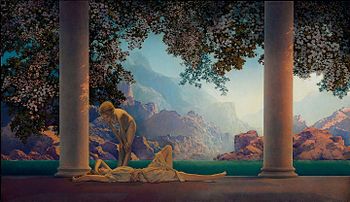Daybreak (painting)
| Daybreak | |
|---|---|
 | |
| Artist | Maxfield Parrish |
| Year | 1922 |
| Dimensions | 67.3 cm × 114 cm (26.5 in × 45 in) |
Daybreak is a painting by American artist Maxfield Parrish made in 1922. Daybreak, inspired by the landscape of Vermont and New Hampshire to create lush and romantic tones,[1] is regarded as the most popular art print of the 20th century, based on number of prints made: one for every four American homes. According to the National Museum of American Illustration, it has outsold Andy Warhol's Campbell's Soup Cans and Leonardo's Last Supper.[2] It is still in print. The painting is also part of the core of the neo-classical popular paintings that started to gain traction at the beginning of the 1920s. His work in his staple style was also popularized by the large scale murals he painted in the 1930s.[3]
Parrish referred to Daybreak as his "great painting", the epitome of his work.
Composition
Measuring 26.5 by 45 inches (67.3 cm × 114 cm),[4] the painting employs a formal layout similar to a stage set, with two feminine figures. Painted using preparatory photographs, the models were his regular models, Kitty Owen (granddaughter of William Jennings Bryan), Parrish's daughter Jean, and Susan Lewin. Only two figures appear in the completed painting, though pencil studies and negative space indicate that the artist originally intended a third near the righthand column.[5] The composition is arranged on the principle of "dynamic symmetry" popularized by Jay Hambidge.[5]
Medium and Technique
Referred to by the artist as "The Great Painting",[6] this 20th century work was created by using oil paints. The technique of glazing, using a varnish over several layers of paint at once helps to achieve the soft glow and whimsical style Parrish is so well known for. Using lighting and natural models to his advantage, Parrish is able to depict a serene setting for the two women, while keeping his tone of slightly out of the ordinary and neo-classic style. In looking at the other works from Parrish at the time, his constant use of mild lighting, and the use of contrasting cool and warm tones, it can be seen that this is how Parrish created his signature style. Like many artists, Parrish also makes use of the Golden Ratio;[7] a technique using math that helps frame the pillars and greenery to add the greatest focus on the two figures in this painting. While Parrish's techniques may have been tedious, almost every single fantasy illustrator one can name borrows from the technique and style of Maxfield Parrish,[8] ensuring that his visions live on.
Record purchase price
The painting has always been in private ownership. On May 25, 2006, Daybreak was purchased by a private collector (Mel Gibson's then-wife, Robyn) at auction at Christie's for US $7.6 million. This set a record price for a Parrish painting. It was sold again on May 21, 2010, for US$5.2 million.
In popular culture
- In 1995, Michael Jackson produced a music video, "You Are Not Alone", featuring himself and his then wife, Lisa Marie Presley, in which they appear semi-nude in emulation of Daybreak.
- The Bloom County comic book Penguin Dreams and Stranger Things features a cover with many elements of Daybreak and other works by Parrish.
- The Dalis Car 1984 album The Waking Hour features a detail from Daybreak on its sleeve.
- The Moody Blues 1983 album The Present features cover artwork that uses a variation of Daybreak.
- A 1986 Nestle television commercial for Alpine White features one scene imitating Daybreak and another resembling Parrish's Ecstasy.
- The Saint Preux album The Last Opera also uses Daybreak for its cover.
- Daybreak in O'Bryonville (2009) is a Cincinnati mural designed for ArtWorks by contemporary artist Kate Holterhoff. Parrish's flowering vine motif figures prominently in Holterhoff's mural.
- The theatrical release poster for the 1987 film The Princess Bride is heavily inspired by Daybreak.
References
- ^ "Maxfield Parrish, A Mechanic Who Painted Fantastically". New England Historical Society. 2018-03-30. Retrieved 2021-12-09.
- ^ "Press Release". The National Museum of American Illustration. July 5, 2006. Archived from the original on July 18, 2006.
- ^ Gilbert, Alma (2005). Maxfield Parrish Master of Make Believe. Old Saybrook CT: Konecky & Konecky. p. 51.
- ^ Gilbert, Alma (1992). Maxfield Parrish: The Masterworks. Berkeley, California: Ten Speed Press. p. 165.
- ^ a b Ludwig, Coy (1973). Maxfield Parrish. Watson-Guptil. p. 142.
- ^ Cutler, Laurence S. (2007). Maxfield Parrish and the American Imagists. Edison, New Jersey: Chartwell Books. p. 230. ISBN 978-0-7858-2263-9. Retrieved 1 June 2024.
- ^ "Learn The Golden Ratio For Your Artworks On Canvas". Upper Canada Stretchers | Art Canvas Stretcher Bars | Serving USA & Canada. Retrieved 2021-12-09.
- ^ foxpudding (2012-04-26). "Maxfield Parrish". The Automat. Retrieved 2021-12-09.
